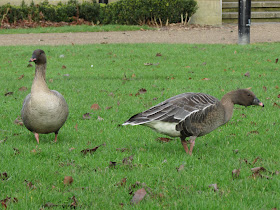I looked carefully at my photos and saw that they have distinct bill markings, one with a very small mark close to the nail, the other with a larger U shape mark. The older bird, with the U shape mark (I'll call her Stripe) appears to the the East Park resident. The younger bird, still with tiny body feathers has a small bill patch and matches the bill marks - and tiny white feathers around its bill - of the one that was at Pearson Park. Despite being younger, this bird was bigger and has a larger head, with a Roman profile and a thicker neck and a heavier head, so it might be well a male. Since last saw both birds I was impressed how much more grown up they look. Their neck stripes are better delineated, their head shapes less gentle, and they have a more silvery backs as they have moulted their juvenile feathers. The Pinkfeet stayed near each other in the flock, but one lunged at the other when it got too close. At some point the flock got wary of a radio controlled car, and after a crescendo of cackles, they flew off.
'Dot' Pearson Park 20/11/2014
East Park, today. A male?
'Stripe' East Park 14/2/2014
East Park, today, a female?
Dot's juvenile feathers very noticeable in the flanks, with some adult feathers, darker and silvery just over his legs.
Stripe seems to have a full adult plumage now.













This is very interesting. Looking at the Greylags in my own London park, I see that some individuals who are easily recognised by white heads, white-flecked feathers, pale plumage etc. drift in and out of the population, appearing for a few days and then not being seen again for months. It seems that there is a constant circulation over the local area. Probably the same thing is going on with the Canadas, but they are more uniform in appearance.
ReplyDeleteI wonder whether it's caused by the committee decisions of the flock. One bird starts calling 'Let's fly, let's fly', with the appropriate movements, and suddenly a whole bunch of geese are off to another park or the river, for no particular reason.
That doesn't explain how two isolated Pinkfeet found each other, but at least random shuffling of the flocks they associate with might bring them together.
Thank you for your comment Ralph. I agree with you, there is a fision-fusion dynamics, with smaller units of birds travelling together and using a range of local areas. In Konrad Lorenz's book with birds he knew, he says that families tend to travel together. I am going to systematically record these 'marker' individuals and it any of them travel together. There is a very lame greylag that can barely use a leg, one with a white head and a family of strikingly orange legs. I have seen them in both large Hull parks. We used to have a hybrid canadaxgreylag travelling with the Canada flock, but he seems to have disappeared.
ReplyDeleteThis comment has been removed by a blog administrator.
ReplyDeleteThis comment has been removed by a blog administrator.
ReplyDelete